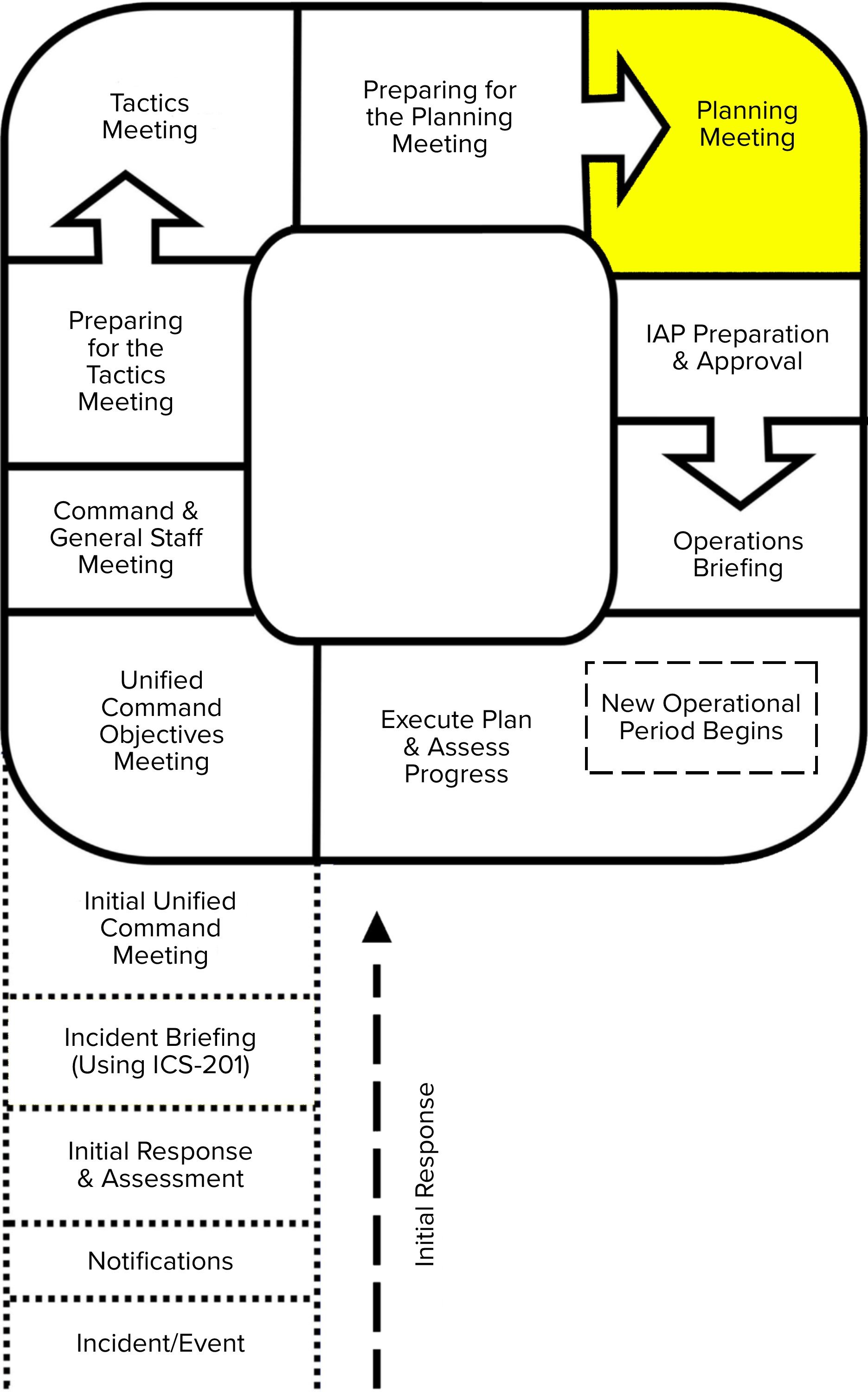1. Planning Section Chief (PSC): Bring the meeting to order, by stating “Good morning/afternoon. It’s [time and date] and I’d like to call the Planning Meeting to order.”
2. Planning Section Chief (PSC): Conduct roll call for the various ICS positions/functions listed below:
Roll Call- Incident Commander (RPIC).
- Federal OSC.
- State OSC.
- Local OSC.
- Safety Officer (SOFR).
- Public Information Officer (PIO).
- Liaison Officer (LOFR).
- Operations Section Chief (OSC).
- Planning Section Chief (PSC).
- Situation Unit Leader (SITL).
- Resources Unit Leader (RESL).
- Environmental Unit Leader (ENVL).
- Documentation Unit Leader (DOCL).
- Logistics Section Chief (LSC).
- Technical Specialists (THSP).
3. Planning Section Chief (PSC): Announce ground rules, as follows:
Example Ground Rules- Silence all electronic devices.
- Respect the meeting agenda.
- Be mindful of time.
- Presenters front and center.
- Limit interruptions and side conversations.
- Table discussions unrelated to the meeting.
4. Planning Section Chief (PSC): Briefly review the agenda, noting the purpose of the meeting is to provide an overview of the proposed tactical plan, based on Unified Command’s (UC’s) priorities and objectives, for the next operational period.
Agenda Overview- Finalize Operational Planning Worksheet (ICS-215) in support of operational activities for the next operational period.
- Review/assign tasks and action items (ICS-233).
- Gain Unified Command (UC) approval of the Incident Action Plan (IAP).
5. Planning Section Chief (PSC): Confirm the Documentation Unit is taking meeting minutes and tracking action items that could potentially arise during the meeting, using Meeting Summary (ICS-231) and Open Action Tracker (ICS-233), respectively.
6. Unified Command (UC): Present opening remarks. Offer words of encouragement, while emphasizing safety and teamwork.
7. Situation Unit Leader (SITL): Provide a brief (less than 3-minute) synopsis of the current and projected incident situation. Highlight recent progress and accomplishments. Review the weather forecast. Use the Situation Map and Incident Status Summary (ICS-209) as references.
8. Safety Officer (SOFR): Issue a quick safety briefing. Highlight Command’s focus on responder/public safety. Address procedures in response to any accidents/injuries.
9. Planning Section Chief (PSC): Reflect upon Command’s incident objectives (ICS-202), priorities, decisions, and direction (ICS-202a).
10. Operations Section Chief (OSC): Provide a briefing on current operations, followed by an overview of the proposed plan. Address strategies, tactics/work assignments, resource commitments, contingencies, organizational elements, incident facilities, logistical support needs, etc. for the next operational period. Use the Situation Map and Operational Planning Worksheet (ICS-215) as references.
11. Planning Section Chief (PSC): Analyze the proposed plan to ensure Unified Command’s (UC’s) priorities are satisfied. Use Work Analysis Matrix (ICS-234) to demonstrate how strategies and tactics are aligned to address “operational” objectives for the next operational period.
12. Planning Section Chief (PSC): Describe Unified Command’s (UC’s) information reporting thresholds and time-critical expectations, as documented on ICS-202b.
13. Planning Section Chief (PSC): Validate responsibility for any open actions/tasks and “management” objectives, using ICS-233.
14. Planning Section Chief (PSC): Conduct a round-robin of Command and General Staff members to solicit their final input and commitment to the proposed plan.
14a. Logistics Section Chief (LSC): Verify the availability of resources to support proposed task assignments. Relate any staffing, transportation, medical, supply, and communications concerns. Clarify resource ordering procedures, as necessary.
14b. Safety Officer (SOFR): Discuss safety considerations/concerns with regards to the proposed operational plan. Reassure Unified Command (UC) that mitigating safety controls are in place for each work assignment.
14c. Public Information Officer (PIO): Evaluate any potential news media or public concerns. Provide an update on the timing/scheduling of media releases, media briefings/press conferences, town hall meetings, media/VIP tours, etc.
14d. Liaison Officer (LOFR): Examine any emerging issues/concerns expressed by agency representatives, elected officials, trustees, and stakeholders. Make everyone aware of scheduled visits by dignitaries, politicians, VIPs, etc.
14e. Finance Section Chief (FSC): Deliver a brief report on expenditures, daily/cumulative costs, burn rate, financial constraints, contract support, claims procedures, etc.
15. Planning Section Chief (PSC): Request Unified Command’s (UC’s) tacit approval of the plan as presented.
16. Planning Section Chief (PSC): Issue assignments to appropriate Incident Management Team (IMT) members for developing Incident Action Plan (IAP) support documentation, along with deadlines. Emphasize the need to complete the IAP well in advance of the Operations Briefing to facilitate a thorough review by the Unified Command (UC).
17. Planning Section Chief (PSC): Adjourn meeting.



